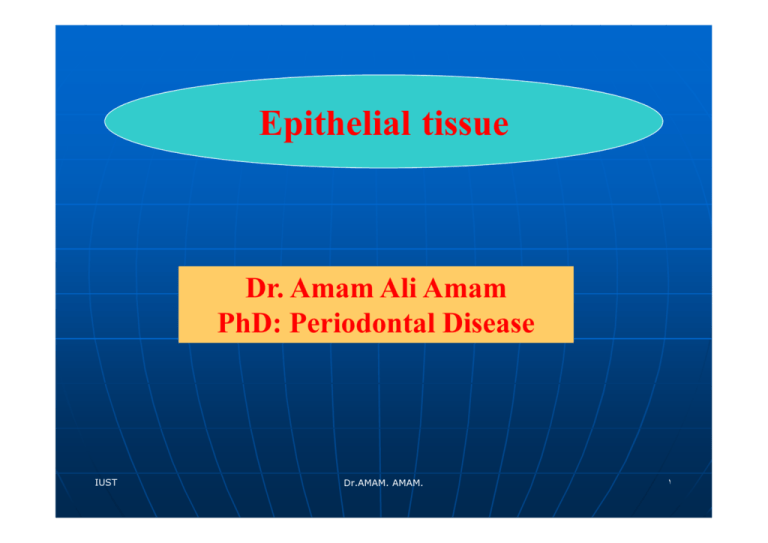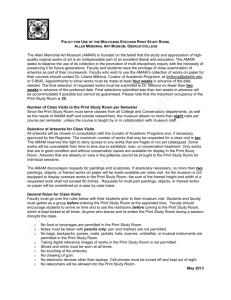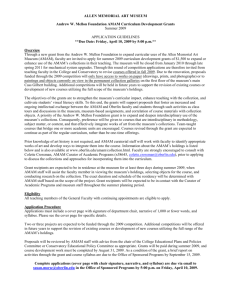Epithelial tissue Amam picture
advertisement

Epithelial tissue Dr. Amam Ali Amam PhD: Periodontal Disease IUST Dr.AMAM. AMAM. ١ The human body is composed of only 4 basic types of tissue Epithelial tissue Connective tissue Muscular tissue Nervous tissue They are formed by: Molecules Cells IUST of the extracellular matrix Dr.AMAM. AMAM. ٢ The main characteristics of these basic types of tissue: tissue Cells Extracellular matrix Main Function Nervous Intertwining None elongated processes Transmission of nervous impulses Epithelial Aggregated polyhedral cells Very small amount Lining of surface or body cavities, glandular secretion Muscle Elongated contractile cells Moderate amount Movement Connective Several types of Abundant amount fixed and wandering cellsDr.AMAM. AMAM. IUST Support and protection ٣ Connective Tissue is characterized by: The abundance of extracellular material produced by its cells. IUST Dr.AMAM. AMAM. ٤ Muscular Tissue is composed of: elongated cells that have the Specialized function of contraction . IUST Dr.AMAM. AMAM. ٥ Nervous Tissue is composed of: cells with elongated processes that receive, generate and transmit nerve impulses IUST Dr.AMAM. AMAM. ٦ Epithelial Tissues are composed of: IUST closely aggregated very little Polyhedral Cells Extracellular Substance Dr.AMAM. AMAM. ٧ Epithelial tissue: These tissues exist not as isolated units but is association with one another and in variable proportions, forming different organs & systems of the body. Epithelial cells covers or line surfaces of the body & cavities (eg, skin, stomach, oral cavity, all tubes inside the blood vessels). IUST Dr.AMAM. AMAM. ٨ The principal Functions of Epithelial tissues are: 1- Covering & lining of surfaces (eg, skin, intestines). 2- Absorption (eg, intestines). 3- Secretion (eg, glands). 4- Sensation (eg, gustative & olfactory neuroepithelium) 5- Contractility (eg, myoepithelial cells) IUST Dr.AMAM. AMAM. ٩ Epithelial Cells are covering & lining surfaces and cavities of the body (external & internal surfaces). Therefore, everything that enter or leave the body should cross the epithelial sheet. IUST Dr.AMAM. AMAM. ١٠ Relationship between Epithelial Cells (E.C). It’s very strong (firm), they should be continuous Because they are going to ( cover, protect, make the function) as perfect as possible. They communicate because they want to know the function of the other, and to live ( if one cell is underworking then the other cell should raise up their level to cover for it ) or if it died. IUST Dr.AMAM. AMAM. ١١ Most organs can be divided into 2 components 1- Parenchyma 2- Stroma It’s the supporting It’s composed of the tissue, it’s made of cells responsible for connective tissue, the main functions except in the brain typical of the organ and spinal cord IUST Dr.AMAM. AMAM. ١٢ Forms of Nucleus & it’s location Epithelial Cell nuclei have distinctive shapes: Epithelial Cell Nucleus shapes Location Cuboidal Squamous Spherical Flattened Central Central Columnar Oval near the Basal The long axis of the nucleus is always parallel to the main axis of the cell. IUST Dr.AMAM. AMAM. ١٣ Specialization of the cell surface 1- Microvilli. 2- Cilia. 3- Flagella. IUST Dr.AMAM. AMAM. ١٤ 1- Microvilli They are found mainly on: 1- the Free cell surface. 2- absorptive cells (lining epithelium of the small intestines & the cells of the proximal renal tubule). IUST Dr.AMAM. AMAM. ١٥ Microvilli IUST Dr.AMAM. AMAM. ١٦ 2- Cilia They are cylindrical motile structures on the surface of some epithelium cells. IUST Dr.AMAM. AMAM. ١٧ 2 Types of Epithelium according to structure & function 2- Glandular Epithelium 1- Covering Epithelium 1-Simple 1-Squamous. 2-Cuboidal. 3-Columnar. IUST 2-Stratified 3- Pseudostratified 1-Squamous keratinized. 2-Squamous non-keratinized 3-Cuboidal. 4-Transitional. 5-Columnar. Dr.AMAM. AMAM. ١٨ Types of covering epithelium 1-Simple 2-Stratified 3- Pseudostratified IUST Dr.AMAM. AMAM. ١٩ Types of covering epithelium Simple Epithelium Patterns 1-Squamous. 2-Cuboidal. 3-Columnar. IUST Dr.AMAM. AMAM. ٢٠ 1- Simple Squamous Epithelium IUST Dr.AMAM. AMAM. ٢١ 1 Simple Squamous Epithelium 1Where it’s Located ? lungs (alveoli). capillary (endothelium). lining of pleural cavity, the pericardium, and the peritoneum. Bowman's capsule (Kidney). Blood vessels (endothelium). IUST Dr.AMAM. AMAM. ٢٢ IUST Dr.AMAM. AMAM. ٢٣ IUST Dr.AMAM. AMAM. ٢٤ Simple Squamous Epithelium IUST Dr.AMAM. AMAM. ٢٥ Simple Squamous Epithelium IUST Dr.AMAM. AMAM. ٢٦ Simple Squamous Epithelium IUST Dr.AMAM. AMAM. ٢٧ Columnar Simple Epithelium IUST Dr.AMAM. AMAM. ٢٨ 2-Simple Cuboidal Epithelium. IUST Dr.AMAM. AMAM. ٢٩ 2- Simple Cuboidal Epithelium IUST Dr.AMAM. AMAM. ٣٠ 2 Simple Cuboidal Epithelium 2Where it’s Located ? IUST follicle of thyroid gland collecting ducts of kidney salivary glands. Pancreas. Ovary. Uterus. Lining of intestine. gallbladder Dr.AMAM. AMAM. ٣١ Cuboidal Simple Epithelium IUST Dr.AMAM. AMAM. ٣٢ Cuboidal Simple Epithelium IUST Dr.AMAM. AMAM. ٣٣ Cuboidal Simple Epithelium IUST Dr.AMAM. AMAM. ٣٤ Cuboidal Simple Epithelium IUST Dr.AMAM. AMAM. ٣٥ Types of covering epithelium 3-Simple Columnar Epithelium. IUST Dr.AMAM. AMAM. ٣٦ IUST Dr.AMAM. AMAM. ٣٧ 3- Simple Columnar Epithelium IUST Dr.AMAM. AMAM. ٣٨ 3 Simple Columnar Epithelium 3Where it’s Located ? Gallbladder. surface epithelium of stomach. Uterine glands (all phases). small intestine IUST Dr.AMAM. AMAM. ٣٩ Types of covering epithelium Type Cell Form Examples of Distribution Squamous Lining of vessels (endothelium). lining of cavities; pericardium, pleura, peritoneum (mesothelium) Simple Cuboidal Covering the ovary, thyroid. Columnar Lining of intestine, gallbladder. IUST Dr.AMAM. AMAM. Main Function Facilitates the movement of the viscera (mesothelium), active transport by pinocytosis (mesothelium & endothelium), secretion of biologically active molecules (mesothelium) Covering, secretion. Protection, lubrication, absorption, secretion. ٤٠ Classification Number of cell layers simple IUST stratified Shape of the component cells squamous cuboidal columnar Presence of surface specialisations keratin microvilli cilia stereocilia Glandular epithelia exocrine exo & endo endocrine Dr.AMAM. AMAM. ٤١ Types of covering epithelium 1-Simple 2-Stratified 3- Pseudostratified IUST Dr.AMAM. AMAM. ٤٢ IUST Dr.AMAM. AMAM. ٤٣ Types of covering epithelium Stratified Epithelium Patterns 1-Squamous keratinized. 2-Squamous non-keratinized 3-Cuboidal. 4- Transitional. 5-Columnar. IUST Dr.AMAM. AMAM. ٤٤ Stratified Squamous keratinized Epithelium • specialised form of stratified squamous epithelium ( epithelial surface of the skin ) epidermis • is adapted to withstand the constant abrasion , and desiccation IUST Dr.AMAM. AMAM. ٤٥ Stratified Squamous keratinized Epithelium IUST Dr.AMAM. AMAM. ٤٦ Stratified Squamous keratinized Epithelium IUST Dr.AMAM. AMAM. ٤٧ Squamous keratinized IUST Dr.AMAM. AMAM. ٤٨ Squamous keratinized IUST Dr.AMAM. AMAM. ٤٩ Squamous keratinized IUST Dr.AMAM. AMAM. ٥٠ Squamous keratinized IUST Dr.AMAM. AMAM. ٥١ Stratified Squamous non-keratinized non keratinized (moist) IUST Dr.AMAM. AMAM. ٥٢ Squamous Non-keratinized IUST Dr.AMAM. AMAM. ٥٣ Squamous Non-keratinized IUST Dr.AMAM. AMAM. ٥٤ Squamous Non-keratinized IUST Dr.AMAM. AMAM. ٥٥ Squamous Stratified Epithelium • consist of a variable number of cells layers : • cuboidal basal layer • flattened surface layer • is well adapted to withstand abrasion , and is poorly adapted to withstand desiccation IUST Dr.AMAM. AMAM. ٥٦ IUST Dr.AMAM. AMAM. ٥٧ Squamous Stratified Epithelium IUST Dr.AMAM. AMAM. ٥٨ Stratified Squamous non-keratinized non keratinized (moist) Where it’s Located ? IUST oral mucosa pharynx esophagus anal canal uterine cervix & vagina Dr.AMAM. AMAM. ٥٩ Squamous Stratified Epithelium IUST Dr.AMAM. AMAM. ٦٠ Transitional Stratified Epithelium Where it’s Located ? IUST Bladder, Ureters, renal calyces. Dr.AMAM. AMAM. ٦١ Transitional Stratified Epithelium • form of stratified epithelium • urinary tract in mammals • highly specialised : a great degree of stretch to withstand the toxicity of urine • it has some features which are intermediate between stratified cuboidal and stratified squamous epithelia IUST Dr.AMAM. AMAM. ٦٢ IUST Dr.AMAM. AMAM. ٦٣ Transitional Stratified Epithelium • in the relaxed state : 4 – 5 cell layers • basal cells are cuboidal. • intermediate cells are polygonal. • surface cells are large and rounded . • in the stretched state : 2 – 3 cell layers . •basal cells are cuboidal . • intermediate and surface cells are flattened IUST Dr.AMAM. AMAM. ٦٤ Transitional Stratified Epithelium IUST Dr.AMAM. AMAM. ٦٥ Transitional Stratified Epithelium IUST Dr.AMAM. AMAM. ٦٦ Transitional Stratified Epithelium IUST Dr.AMAM. AMAM. ٦٧ Cuboidal Stratified Epithelium Where it’s Located ? IUST Ducts of sweat glands, developing ovarian follicles. Dr.AMAM. AMAM. ٦٨ Cuboidal Epithelium IUST Dr.AMAM. AMAM. ٦٩ Cuboidal Stratified Epithelium • only two or three layers • not involved in significant absorptive or secretory activity but provides a more robust lining than would be afforded by a simple epithelium • lining of the larger secretory ducts of exocrine glands IUST Dr.AMAM. AMAM. ٧٠ Types of covering epithelium Type Cell Form Examples of Distribution Surface layer squamous keratinized (dry). Epidermis. Protection ; prevents water loss. Mouth,esophagus, larynx, vagina, anal canal Protection, secretion; prevents water loss. Cuboidal Sweat glands, developing ovarian follicles. Protection, secretion. Transitional: domelike to flattened, depending on the organ. Bladder, Ureters, renal calyces. Protection, distensibility. Columnar. Conjunctiva. Protection. Surface layer squamous Stratified nonkeratinized (moist). IUST Main Function Dr.AMAM. AMAM. ٧١ Ciliated Pseudostratified Epithelium IUST Maxillary Sinus Dr.AMAM. AMAM. ٧٢ Pseudostratified columnar Epithelium IUST Dr.AMAM. AMAM. Trachea ٧٣ Pseudostratified Epithelium IUST Dr.AMAM. AMAM. ٧٤ Pseudostratified Epithelium IUST Dr.AMAM. AMAM. ٧٥ Pseudostratified Epithelium IUST Dr.AMAM. AMAM. ٧٦ Pseudostratified Epithelium IUST Dr.AMAM. AMAM. ٧٧ Common types of covering epithelia in the human body Type Simple Pseudostratified Stratified IUST Cell Form Examples of Distribution Main Function Squamous Lining of vessels (endothelium). Serous lining of cavities; pericardium, pleura, peritoneum (mesothelium) Facilitates the movement of the viscera (mesothelium), active transport by pinocytosis (mesothelium & endothelium), secretion of biologically active molecules (mesothelium) Cuboidal Covering the ovary, thyroid. Covering, secretion. Columnar Lining of intestine, gallbladder. Protection, lubrication, absorption, secretion. Some columnar & some cuboidal. Lining of trachea, bronchi, nasal cavity. Protection, secretion; ciliamediated transport of particles trapped in mucus. Surface layer squamous keratinized (dry). Epidermis. Protection ; prevents water loss. Surface layer squamous nonkeratinized (moist). Mouth, esophagus, larynx, vagina, anal canal Protection, secretion; prevents water loss. Cuboidal Sweat glands, developing ovarian follicles. Protection, secretion. Transitional: domelike to flattened, depending on the organ. Bladder, Ureters, renal calyces. Protection, distensibility. Columnar. Conjunctiva. ٧٨ Dr.AMAM. AMAM. Protection. Glandular Epithelium 1. 2. 3. Glandular epithelial cells (store & secrete : proteins (eg: pancreas) lipids, ( eg: sebaceous glands) carbohydrates and proteins, (eg: salivary glands) • • IUST Mammary glands do all that. Secretes substances from the blood, sweat glands Dr.AMAM. AMAM. ٧٩ Types of glands 1. 2. IUST Unicellular: goblet glands. Multicellular: Exocrine Endocrine Dr.AMAM. AMAM. ٨٠ Glandular Epithelium IUST Dr.AMAM. AMAM. ٨١ Glandular Epithelium, Exocrine glands The morphology of the gland Simple glands • single, unbranched duct, secretory portions. tubular or acinar , coiled or branched. Compound glands • branched duct system secretory portions have similar morphological forms to those of simple glands IUST Dr.AMAM. AMAM. ٨٢ The means of discharge of secretory form the cells فارزة • Merocrine secretion ( eccrine ) - salivary glands َ ُم ْف َتApocrine secretion - breast , sweat glands • رزة • ُم ْن َف ِر َزةHolocrine secretion - sebaceous glands IUST Dr.AMAM. AMAM. ٨٣ IUST Dr.AMAM. AMAM. ٨٤ Stomach Several tubular secretory portions, single unbranched duct , is lined by mucus-secreting cells. No goblet cells IUST Dr.AMAM. AMAM. ٨٥ Simple acinar glands Mucus-secreting glands / Penilee urethra IUST Dr.AMAM. AMAM. ٨٦ Sebaceous glands Several secretory acini , single excretory duct - stratified e. IUST Dr.AMAM. AMAM. ٨٧ Brunner’s glands / duodenum Duct is branched, tubularDr.AMAM. branched coiled secretory portions٨٨ AMAM. IUST IUST Pancreas Dr.AMAM. AMAM. ٨٩ IUST Dr.AMAM. AMAM. ٩٠ IUST Submandibular salivary gland Dr.AMAM. AMAM. ٩١ Endocrine glands • ductless • secretory products – HORMONES • rich network of small blood vessels IUST Dr.AMAM. AMAM. ٩٢





